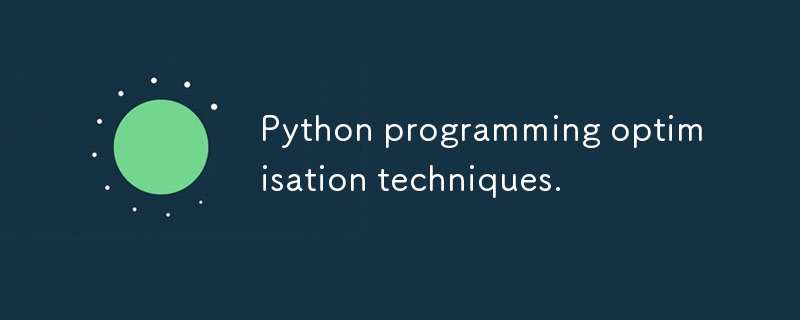Python编程优化技术。

优化代码至关重要,因为它直接影响软件的效率、性能和可扩展性。编写良好的代码运行速度更快,消耗的资源更少,并且更易于维护,使其更适合处理更大的工作负载并改善用户体验。它还降低了运营成本,因为高效的代码需要更少的处理能力和内存,这在资源有限的环境中尤其重要,例如嵌入式系统或大规模云应用程序。
另一方面,编写得不好的代码可能会导致执行时间变慢、能源消耗增加以及基础设施成本更高。例如,在 Web 应用程序中,低效的代码可能会减慢页面加载速度,导致用户体验不佳,并可能导致用户流失。在数据处理任务中,低效的算法会显着增加处理大型数据集所需的时间,从而延迟关键的见解和决策。
此外,优化的代码通常更容易维护和扩展。通过遵循优化最佳实践,开发人员可以确保其代码库保持干净和模块化,从而更轻松地根据需要更新或扩展应用程序。随着软件项目复杂性的增加以及对系统的需求的增加,这一点变得越来越重要。
让我们探索 10 种 Python 编程优化技术,它们可以帮助您编写更高效、性能更高的代码。这些技术对于开发满足性能要求同时保持可扩展性和可维护性的强大应用程序至关重要。通过遵循最佳实践,这些技术也可以应用于其他编程语言。
1. 可变包装
变量打包通过将多个数据项分组到单个结构中来最大限度地减少内存使用。在内存访问时间显着影响性能的场景(例如大规模数据处理)中,此技术至关重要。当相关数据打包在一起时,可以更有效地使用 CPU 缓存,从而加快数据检索速度。
示例:
import struct
# Packing two integers into a binary format
packed_data = struct.pack('ii', 10, 20)
# Unpacking the packed binary data
a, b = struct.unpack('ii', packed_data)
在这个例子中,使用 struct 模块将整数打包成紧凑的二进制格式,使数据处理更加高效。
2. 存储与内存
理解存储(磁盘)和内存(RAM)之间的区别至关重要。内存操作速度更快,但易失性,而存储是持久的,但速度较慢。在性能关键型应用程序中,将频繁访问的数据保留在内存中并最大限度地减少存储 I/O 对于速度至关重要。
示例:
import mmap
# Memory-mapping a file
with open("data.txt", "r+b") as f:
mmapped_file = mmap.mmap(f.fileno(), 0)
print(mmapped_file.readline())
mmapped_file.close()
内存映射文件允许您将磁盘存储视为内存,从而加快大文件的访问时间。
3. 固定长度变量与可变长度变量
固定长度变量存储在连续的内存块中,从而使访问和操作更快。另一方面,可变长度变量需要额外的开销来管理动态内存分配,这可能会减慢操作速度,特别是在实时系统中。
示例:
import array
# Using fixed-length array for performance
fixed_array = array.array('i', [1, 2, 3, 4, 5])
# Dynamic list (variable-length)
dynamic_list = [1, 2, 3, 4, 5]
这里,array.array 提供了一个固定长度的数组,提供比动态列表更可预测的性能。
4. 内部与公共职能
内部函数是那些仅在定义它们的模块内使用的函数,通常针对速度和效率进行优化。公共函数公开供外部使用,并且可能包括额外的错误处理或日志记录,这使得它们的效率稍低。
示例:
def _private_function(data):
# Optimized for internal use, with minimal error handling
return data ** 2
def public_function(data):
# Includes additional checks for external use
if isinstance(data, int):
return _private_function(data)
raise ValueError("Input must be an integer")
通过将大量计算保留在私有函数中,您可以优化代码的效率,保留公共函数以实现外部安全性和可用性。
5. 功能修饰符
在Python中,装饰器充当函数修饰符,允许您在函数主执行之前或之后添加功能。这对于缓存、访问控制或日志记录等任务非常有用,可以优化多个函数调用之间的资源使用。
示例:
from functools import lru_cache
@lru_cache(maxsize=100)
def compute_heavy_function(x):
# A computationally expensive operation
return x ** x
使用 lru_cache 作为装饰器缓存昂贵的函数调用的结果,通过避免冗余计算来提高性能。
6. 使用图书馆
利用库可以让您避免重新发明轮子。像 NumPy 这样的库是用 C 语言编写的,并且是为了性能而构建的,与纯 Python 实现相比,它们对于繁重的数值计算来说更加高效。
示例:
import numpy as np # Efficient matrix multiplication using NumPy matrix_a = np.random.rand(1000, 1000) matrix_b = np.random.rand(1000, 1000) result = np.dot(matrix_a, matrix_b)
Here, NumPy's dot function is enhanced for matrix operations, far outperforming nested loops in pure Python.
7. Short-Circuiting Conditionals
Short-circuiting reduces unnecessary evaluations, which is particularly valuable in complex condition checks or when involving resource-intensive operations. It prevents execution of conditions that don't need to be checked, saving both time and computational power.
Since conditional checks will stop the second they find the first value which satisfies the condition, you should put the variables most likely to validate/invalidate the condition first. In OR conditions (or), try to put the variable with the highest likelihood of being true first, and in AND conditions (and), try to put the variable with the highest likelihood of being false first. As soon as that variable is checked, the conditional can exit without needing to check the other values.
Example:
def complex_condition(x, y):
return x != 0 and y / x > 2 # Stops evaluation if x is 0
In this example, Python’s logical operators ensure that the division is only executed if x is non-zero, preventing potential runtime errors and unnecessary computation.
8. Free Up Memory
In long-running applications, especially those dealing with large datasets, it’s essential to free up memory once it’s no longer needed. This can be done using del, gc.collect(), or by allowing objects to go out of scope.
Example:
import gc # Manual garbage collection to free up memory large_data = [i for i in range(1000000)] del large_data gc.collect() # Forces garbage collection
Using gc.collect() ensures that memory is reclaimed promptly, which is critical in memory-constrained environments.
9. Short Error Messages
In systems where memory or bandwidth is limited, such as embedded systems or logging in distributed applications, short error messages can reduce overhead. This practice also applies to scenarios where large-scale error logging is necessary.
Example:
try:
result = 10 / 0
except ZeroDivisionError:
print("Err: Div/0") # Short, concise error message
Short error messages are useful in environments where resource efficiency is crucial, such as IoT devices or high-frequency trading systems.
10. Optimize Loops
Loops are a common source of inefficiency, especially when processing large datasets. Optimising loops by reducing iterations, simplifying the logic, or using vectorised operations can significantly improve performance.
Example:
import numpy as np # Vectorised operation with NumPy array = np.array([1, 2, 3, 4, 5]) # Instead of looping through elements result = array * 2 # Efficient, vectorised operation
Vectorisation eliminates the need for explicit loops, leveraging low-level optimisations for faster execution.
By applying these techniques, you can ensure your Python or other programming language programs run faster, use less memory, and are more scalable, which is especially important for applications in data science, web and systems programming.
PS: you can use https://perfpy.com/#/ to check python code efficiency.
以上是Python编程优化技术。的详细内容。更多信息请关注PHP中文网其他相关文章!

热AI工具

Undresser.AI Undress
人工智能驱动的应用程序,用于创建逼真的裸体照片

AI Clothes Remover
用于从照片中去除衣服的在线人工智能工具。

Undress AI Tool
免费脱衣服图片

Clothoff.io
AI脱衣机

AI Hentai Generator
免费生成ai无尽的。

热门文章

热工具

记事本++7.3.1
好用且免费的代码编辑器

SublimeText3汉化版
中文版,非常好用

禅工作室 13.0.1
功能强大的PHP集成开发环境

Dreamweaver CS6
视觉化网页开发工具

SublimeText3 Mac版
神级代码编辑软件(SublimeText3)














